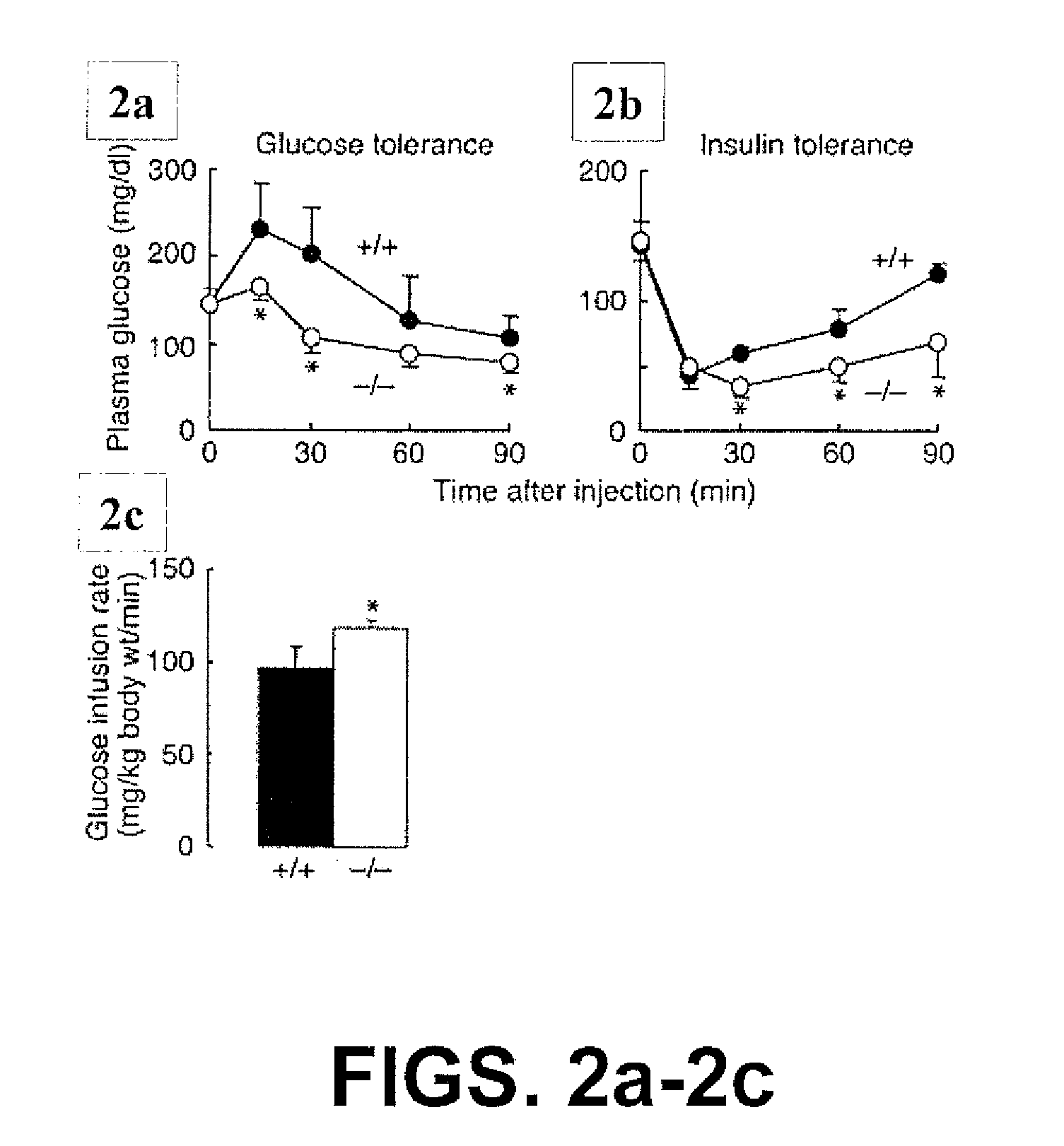Genetically modified mouse lacking diacylglycerol acyltransferase-1 (DGAT-1) activity
a technology of acyltransferase and mouse, which is applied in the direction of transferases, metabolic disorders, instruments, etc., can solve the problems of inability to respond properly, no effective drug-based treatment for human obesity is currently available, and high risk of health problems, so as to improve or decrease blood glucose levels, modulate carbohydrate metabolism, and improve the effect of glucose metabolism
- Summary
- Abstract
- Description
- Claims
- Application Information
AI Technical Summary
Benefits of technology
Problems solved by technology
Method used
Image
Examples
example i
Preparation and Characterization of DGAT Knockout Mice
[0170]DGAT knockout mice were generated using standard techniques of gene targeting. A mouse P1 clone containing the mouse DGAT gene was isolated from a genomic 129 / Sv library. Short and long arms of homologous sequences were amplified by PCR from this clone and subcloned intopNTKLoxP to generate a gene targeting vector. The vector contained a neomycin resistance gene for positive selection and a thymidine kinase gene for negative selection. Upon homologous recombination, the vector was designed to interrupt the DGAT coding sequences at amino acid 360 of the 498-amino acid murine protein. The entire C-terminus, including a highly conserved region common to all ACAT gene family members is deleted. The gene targeting vector was electroporated into RF8 embryonic stem cells by electroporation, and several targeted clones were identified by Southern blotting (targeting frequency of ˜1 in 300).
[0171]One of these targeted clones was inj...
example ii
Altered Lipid Composition in Tissues of Dgat1− / − Mice
[0173]Dgat1− / − mice had a 30-40% reduction of triglyceride levels in WAT and skeletal muscle (Table 2). Liver triglyceride levels trended lower in chow-fed Dgat1− / − mice. On a high-fat diet, however, Dgat1− / − mice had significantly lower liver triglyceride levels than Dgat1+ / + mice (28±16 versus 157±28 mg / g tissue weight, P− / − tissues (Table 2). DGAT1 deficiency also altered the fatty acid composition of triglycerides in WAT and skeletal muscle, resulting in a relative decrease in monounsaturated (16:1 and 18:1) fatty acids and a relative increase in saturated (16:0 and 18:0) fatty acids (Table 2).
[0174]
TABLE 2Lipid composition of tissues in Dgat1− / − and Dgat1+ / + miceTriglyceridesDiacylglycerolFatty acid composition of triglycerides (% of total fatty acids)(% of tissue weight)16:016:118:018:118:2w618:3w618:3w3White adipose tissue+ / +32.4 ± 7.9 0.06 ± 0.0220.0 ± 0.68.4 ± 1.21.8 ± 0.237.3 ± 1.225.3 ± 1.90.3 ± 0.30.7 ± 0.1− / −20.3 ± 3....
example iii
Decreased Adipocyte Size in Dgat1− / − Mice
[0175]Concomitant with the decreased triglyceride levels in WAT, Dgat1− / − mice had smaller adipocytes than Dgat1+ / + mice on both chow and high-fat diets (FIG. 1). Adipocytes from Dgat1− / − mice developed minimal hypertrophy in response to a high-fat diet, whereas those from Dgat1+ / + mice doubled in size. This protection from diet-induced adipocyte hypertrophy in Dgat1− / − mice mirrored their weight response to a high-fat diet. In addition to having smaller adipocytes, male Dgat1− / − mice had a lower mean DNA content in reproductive fat pads than Dgat1+ / + mice (169±36 versus 273±50 μg / fat pad, P− / − mice also had fewer adipocytes.
PUM
| Property | Measurement | Unit |
|---|---|---|
| w/w | aaaaa | aaaaa |
| temperature | aaaaa | aaaaa |
| temperature | aaaaa | aaaaa |
Abstract
Description
Claims
Application Information
 Login to View More
Login to View More - R&D
- Intellectual Property
- Life Sciences
- Materials
- Tech Scout
- Unparalleled Data Quality
- Higher Quality Content
- 60% Fewer Hallucinations
Browse by: Latest US Patents, China's latest patents, Technical Efficacy Thesaurus, Application Domain, Technology Topic, Popular Technical Reports.
© 2025 PatSnap. All rights reserved.Legal|Privacy policy|Modern Slavery Act Transparency Statement|Sitemap|About US| Contact US: help@patsnap.com



